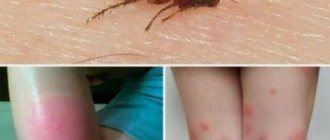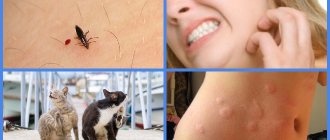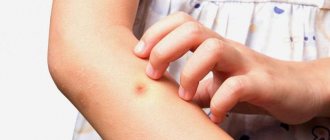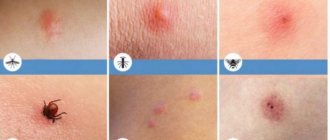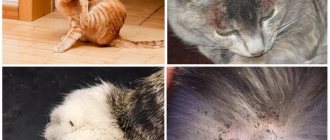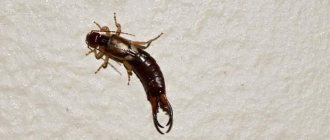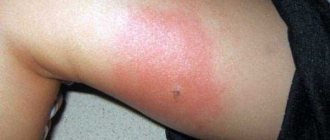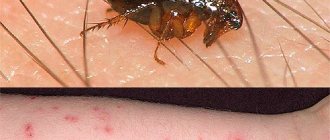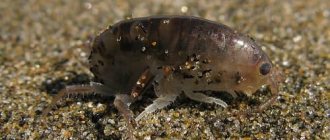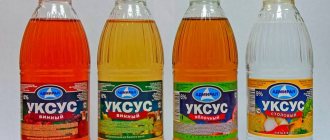Fleas often live in apartments with pets or are brought into the house in other ways; they bite people, including children. Adults usually hardly notice them, but flea bites in children are another matter: the photo shows how strong and dangerous a reaction they can cause in the body of a small child.
Flea bites in children
Symptoms of flea bites
A flea bite on a child can be confused with the consequences of an attack by other blood-sucking insects, but according to some features and symptoms they can be accurately identified:
- flea bites cause severe itching and are painful for young children;
- due to the baby’s delicate skin, lumps and bumps may form in the bitten area, inside which subcutaneous hemorrhage is possible;
- flea bites look like tracks of several wounds;
- a large number of bite marks occur on those parts of the body where there is no clothing: legs, ankles, lower back, because fleas are not able to crawl under the fabric;
- In addition to spots, a rash similar to hives often appears on the body, which is a symptom of an allergic reaction.
Knowing exactly what flea bites look like in children, parents should as soon as possible discover the source of their settlement and take measures to destroy the parasites.
How to keep children safe?
Flea remedies
Preventive measures will help prevent flea bites in children. The main thing is disinfestation of residential premises. Before you start treating the apartment, you need to destroy parasites on pets. Shampoos, sprays, drops, collars and other means are suitable for this. You can find out which one is suitable for your particular pet from your veterinarian.
Fleas live not only on the body of the owner, but can also hide under baseboards, in carpets, floor crevices, upholstery and even in cribs. The treatment of the premises must be comprehensive. Anyone who is not confident in their own abilities should contact a specialized company. Exterminators use drugs that are poisonous to fleas, but safe for humans and pets. The result is the complete destruction of bloodsuckers and their larvae.
To avoid re-infection, you need to ensure that children and pets do not have contact with stray animals. Cats and dogs should walk in anti-flea collars impregnated with special compounds.
To protect your child from insect attacks outside the home, you can use special ointments or sprays. The content of the active component (DEET) in them should be no more than 5–10%. Children under 3 years of age are a contraindication to the use of repellents.
Effect of flea bites
The consequences of flea bites in children can be quite unpleasant:
- the layer of the baby’s epidermis is very thin and delicate, as a result of which flea bites in a child are very painful, they itch very much and do not heal for a long time, and children often scratch them;
- in a child who has a tendency to allergies due to an imperfect immune system, negative manifestations can be strong;
- in rare cases, children develop subcutaneous hemorrhages, which result in the disease “pulicosis”; it is treated by a dermatologist;
- fleas are carriers of infections, including worm eggs, which they can transmit through a bite;
- Children bitten by parasites may experience severe fear and nervous shock, which will require treatment from a psychologist.
Why are they dangerous?
How dangerous are flea bites for a child? Since insects are not selective in food sources, they can parasitize any animal, including rodents, and they are carriers of various infectious diseases.
A flea bite can cause infection with dangerous diseases such as plague, hepatitis, encephalitis, trypanosomiasis, anthrax, and many others.
In addition, the flea can act as a carrier of eggs of various helminths.
Treatment of flea bites in children
Treatment of bites in children
Treatment of flea bites in a child should begin as soon as the parents notice red spots and wounds on the baby’s body. The first step is to wash them with a disinfectant: hydrogen peroxide, chlorhexidine or soap and water.
On a note!
When treating flea bites in children, rinse wounds only with cold water, since warm and hot water will only increase the unpleasant irritating sensations.
To relieve itching, apply a cotton swab soaked in soda solution or a piece of ice wrapped in a cloth to the wound. An aqueous solution of apple cider vinegar relieves burning well.
One of the problems in treatment is relieving itching; parents can be advised how to apply flea bites on a child:
- ointments Boro-plus (90 rubles), Rescuer (220 rubles), calamine lotion (560 rubles);
- Fenistil (RUR 330) – antihistamine cream that relieves itching, redness and inflammation;
- Bepanten (from 220 rubles) - with the help of dexapanthenol, it has an anti-inflammatory, wound-healing, cooling and moisturizing effect, is harmless to babies;
- Psilo-balm (210 rubles), containing diphenhydramine, which is good for relieving itching and possible allergic reactions;
- Nezulin (RUB 112) is a medicinal product with components of plant extracts and oils, suitable for delicate children's skin, relieves itching and inflammation.
For treatment, you can also use herbal and folk recipes:
- make an aqueous solution of 1 teaspoon of soda and ammonia in 1 tbsp. boiled water and treat the bite areas;
- make a compress from grated potato or raw onion;
- prepare a mixture of 1 tbsp. l. honey and 1 tbsp. lemon juice, freshly squeezed, and apply to areas of inflammation;
- To reduce the inflammatory process, it is recommended to lubricate the bitten areas with the juice of dandelion, plantain leaves and parsley, and rub with a clove of garlic.
Folk remedies
The following remedies will relieve pain:
- Vinegar. Mix the apple product with water in equal proportions. Treat the bite areas with a ready-made product (for convenience, you can use a cotton swab). Vinegar will soothe irritated skin, relieve itching and redness.
- Aloe. Cut a plant leaf lengthwise and apply the inside to the affected areas of the body. Secure with adhesive tape or bandage.
- Decoction of medicinal herbs. Mix plantain, coltsfoot, calendula, chamomile and green tea in equal proportions. Place 2-3 tbsp in a saucepan. l. collection, pour boiling water over low heat. After 15 minutes, remove the pan from the stove and strain the liquid. Wipe the skin with the prepared decoction several times a day.
- Baking soda. Pour 1 tsp. baking soda with a glass of warm water, stir. Use the resulting solution to wipe the skin, lotions or compresses.
If there are a large number of bites, the skin should be treated with a solution of honey and lemon juice. To prepare the product you will need 1 spoon of beekeeping product and 2 glasses of freshly squeezed juice.
Allergy to flea bites
Allergy to flea bites
Flea bites are dangerous due to the unpredictability and likelihood of a strong reaction of the body to multiple flea bites in a child. This is explained by more delicate skin, an immature immune system and the possibility of rapid changes in blood composition with a large number of bites. Of particular danger is a serious complication that can occur in a child with allergies - anaphylactic shock.
Allergic reactions are caused in children by an enzyme that the flea injects under the skin when biting, which reduces blood clotting. When a large amount of this enzyme accumulates, which can happen during a massive attack of parasites, the reaction of the child’s body is manifested in a strong immune response to the ingress of an irritating substance.
It is necessary to carefully examine the baby’s skin for the presence of an allergic rash and other unpleasant consequences. If they are, then an antihistamine should be given.
In addition to the rash, there are also symptoms of an allergy to flea bites in a child, for which treatment must be carried out under the supervision of a doctor:
- numerous skin rashes;
- increase in body temperature to 38-39ºС;
- swelling of the mucous membrane, nasopharyngeal congestion;
- enlarged lymph nodes;
- diarrhea.
First aid for a flea bite
If a bite occurs, wash the affected area with warm water and antiseptic soap. To relieve pain, apply ice or any product from the freezer to the wound.
Then the flea bites are treated with antiseptics. For this use:
- Chlorhexedine;
- Miramistin;
- Iodine;
- Hydrogen peroxide.
If the wound is very swollen and severe rashes appear around it, this indicates the development of a histamine reaction. In this case, antiallergic drugs are used internally and locally.
Among local drugs, Fenistil and Spasatel have proven themselves well. The gel is applied to the sore spot three times a day. The product relieves swelling, itching, and rash well.
Effective oral medications include: Zyrtec, Eden, Loratadine, Diazolin.
Antihistamines are available without a prescription, but must be prescribed by your doctor because they sometimes cause side effects.
If allergic manifestations are severe, hormonal medications are used. They are administered intravenously or intramuscularly.
Ways to cause fleas to appear in an apartment and fight them
In order to prevent fleas from settling in an apartment or house, you should know where these harmful insects can come from.
Routes of entry for fleas:
- on the fur of pets that walk outside;
- from basements or attics, parasites can jump to nearby apartments;
- Residents themselves can bring insects on their clothes or shoes.
After parasites enter an apartment, they choose habitats in the lower part of the room, where they can jump: carpets, cracks in the floor, upholstered furniture, etc.
Preventive measures against flea bites in children
To prevent the situation when fleas bite a child from happening again, preventive measures should be taken in the house or apartment:
- to repel insects in the house, you can hang branches of wormwood and tansy, which do not tolerate such odors;
- pour pine sawdust into pet bedding and add wormwood;
- to protect a child from fleas, he should be dressed in more closed clothing, through which insects are not able to bite;
- There are special repellents in the form of creams and sprays that can be applied to a child to prevent fleas from biting them: Deta-baby, which helps protect the baby from bites of blood-sucking insects for 3 hours (used from the age of 3); Garden Baby (approved for children from 1.5 years old);
- To protect babies and prevent allergies to medications, it is recommended to apply the cream not to the skin, but to the underwear and even the surface of the diaper - this will repel insects.
All of the above measures will help prevent “bloodsuckers” from settling in the house and will prevent children from suffering from their bites.
What infections can fleas carry?
Parasites feed on the blood of healthy, sick and even dead people and animals. When a flea bites a person, the viruses enter the skin and are carried throughout the body through the blood.
The most dangerous diseases that bloodsucking animals can carry:
- anthrax;
- salmonellosis;
- encephalitis;
- typhus;
- tapeworms;
- fungal infections;
- listeriosis;
- tularemia;
- plague.
The greatest danger is posed by fleas that live on rats. These rodents feed on spoiled foods and dead animals and carry dangerous diseases.
If rats appear in the basement of the house, you need to destroy the rodents and carry out a complete treatment of the room. Companies specializing in disinsection and deratization can best cope with this task.
